Nestled along the rugged Causeway Coast of Northern Ireland, Portrush holds a legacy woven through with wind, sea, and the unmistakable sound of a well-struck golf ball. More than a scenic town, Portrush has long stood as a beacon in the evolution of golf, its fairways shaping generations of players and its landscape leaving a mark on the sport’s rich tapestry.
From the arrival of the railway in 1855 to the global tournaments of the modern day, Portrush’s journey as a golfing haven is both storied and significant.
The establishment of Royal Portrush Golf Club and the spirited rise of pioneering players—especially the women who redefined the game—stand as testament to the town’s influence. Legendary names like Old Tom Morris, Rhona Adair, and May Hezlet didn’t just visit; they helped shape Portrush’s reputation as the ‘St Andrews of Ireland.’
Delve into the town’s enduring relationship with golf, exploring how people, place, and passion have forged its identity. Whether through thoughtful course design or moments of courageous trailblazing, Portrush has constantly redefined excellence. It is this spirit that continues to echo across its dunes and greens, reverberating through the history of the game itself.
Spreading the Word of Golf
Railways unleashed a hunger for travel in the 19th Century and helped to spread the ‘word of golf’. The travelling golfer was enticed with reduced fares and the free use of golf greens.
The arrival of the railway to Portrush in 1855 brought many changes and suddenly this remote coastal town became more accessible. Portrush began to grow in popularity and became renowned for its air and sea baths, a popular Victorian health trend. Many visitors also came to Portrush by the regular passenger boat service from Glasgow.
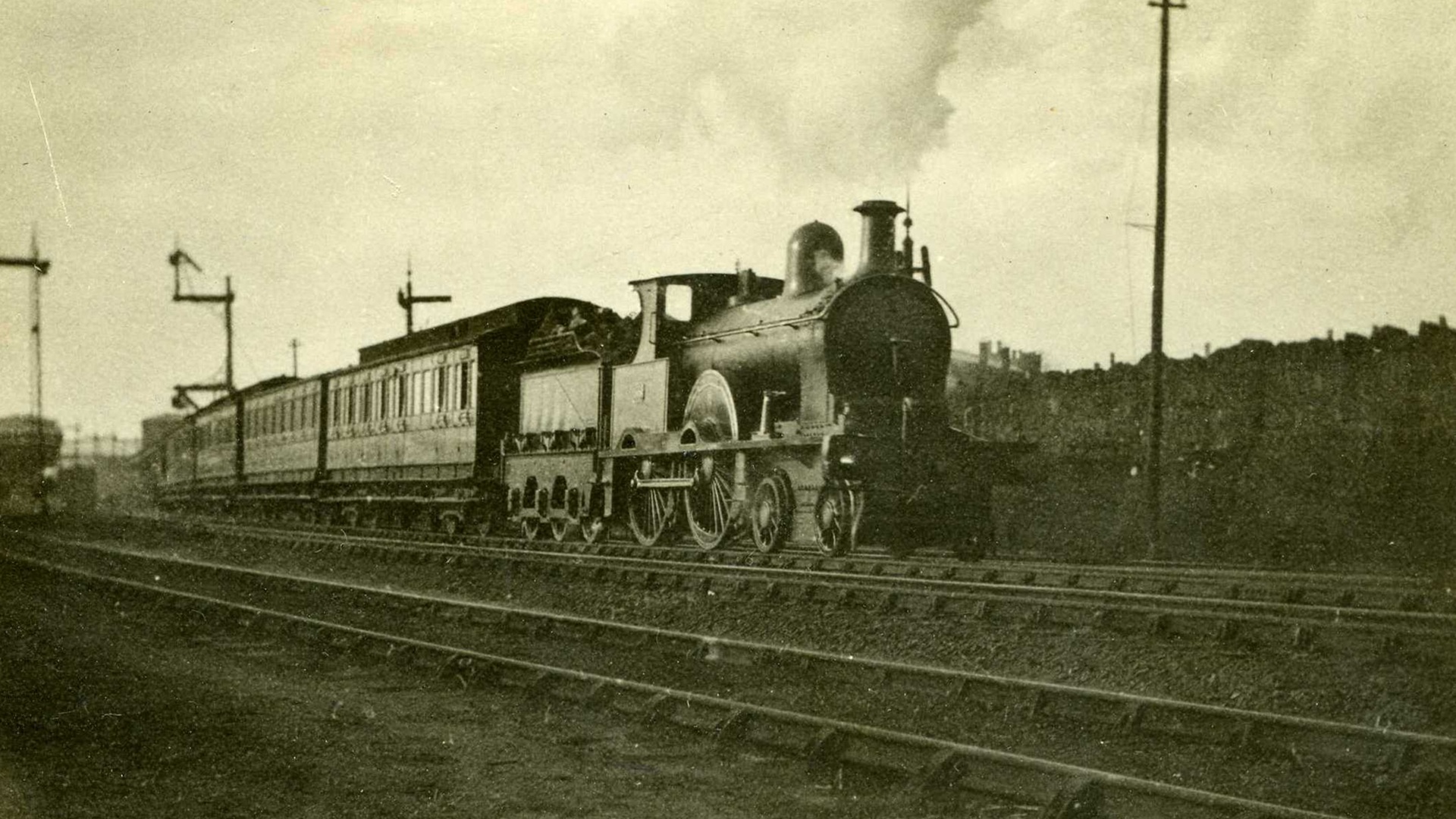
© Causeway Coast & Glens Museum Services
Green with Envy
With its wild landscape of linksland, Portrush was perfect for golf. The Belfast News Letter on Monday April 2 1888, reported that there was a new green that had been laid at Portrush and it was in close proximity to the Railway Station. This added to the towns many attractions as a tourist destination and the golfer would now no longer need to travel across the water to play the ancient game.
Golf Links
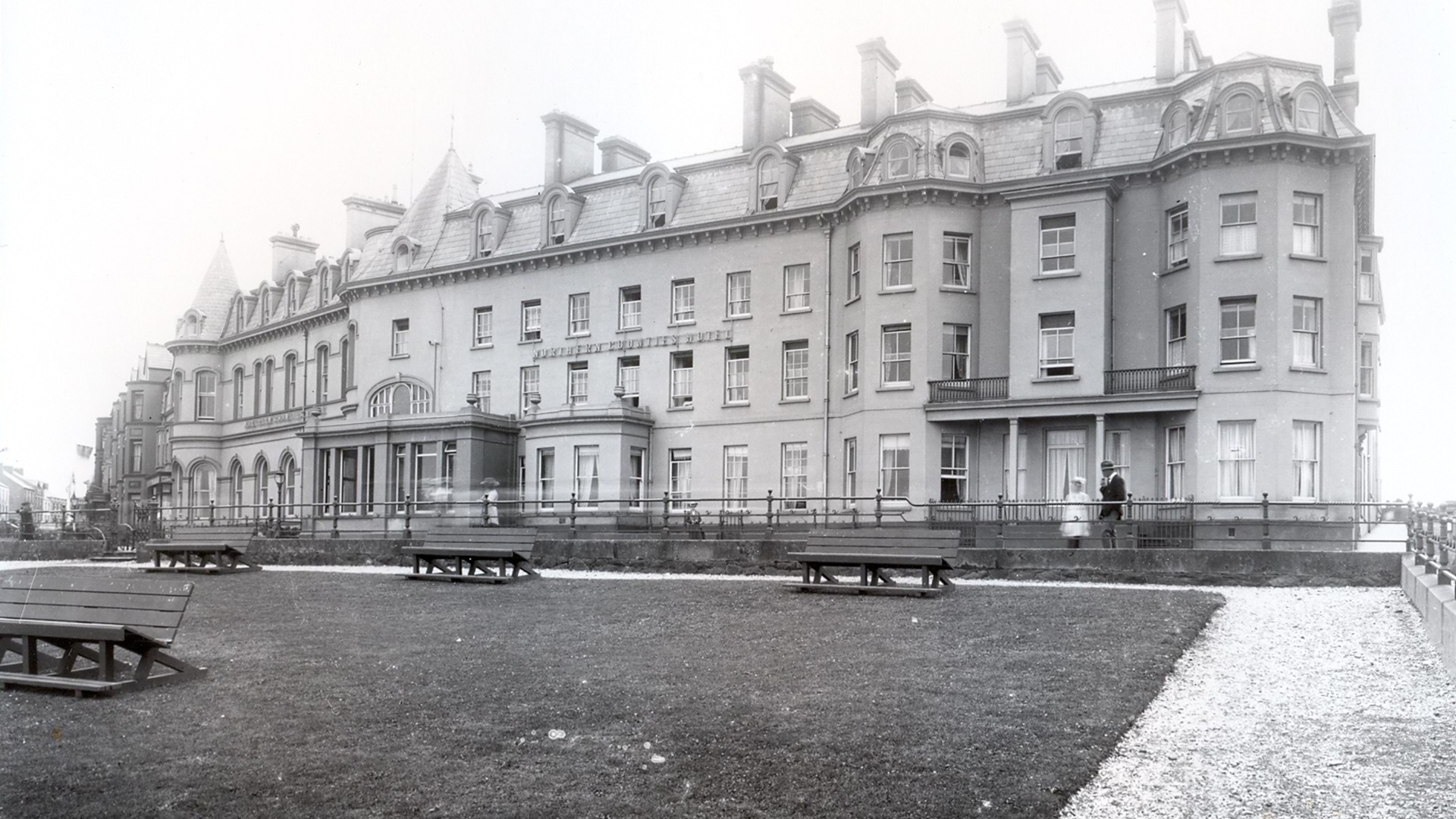
© Causeway Coast & Glens Museum Services
George Lockhart Baillie and Thomas Gilroy were early practitioners of the game of golf having learned to play in their native Scotland. Together, with support from the Belfast & Northern Counties Railway (BNCR), steps were taken to establish a golf club in Portrush. On April 21, 1888 a meeting was held in the Northern Counties Hotel.
BNCR owned the Northern Counties Hotel, further aligning the railway with the development of golf in Portrush, and it was agreed that residents of the hotel could play on the green free of charge while visitors residing elsewhere in the town would have to pay.
Join the Club
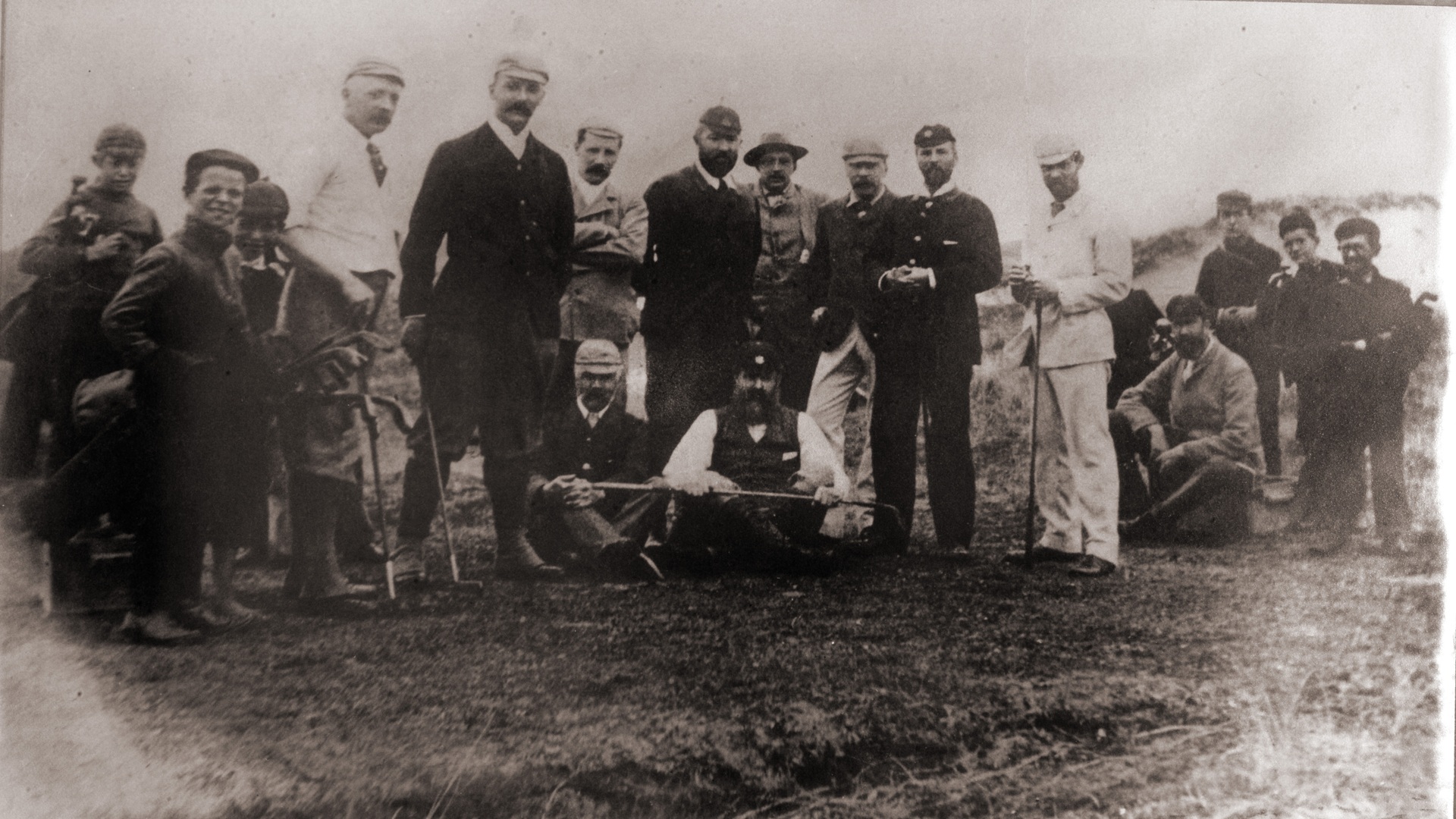
© Royal Portrush Golf Club
In May 1888, the first golf club in Portrush had its official opening and was called ‘The County Golf Club’. Members from the Royal Belfast Golf Club travelled by train to inaugurate the opening of the new golf club.
Local newspapers reported how residents stared in amazement at the golfers as they played the game, resplendent in their red coats.

© Royal Portrush Golf Club
The St Andrews of Ireland
Portrush became renowned for its ‘good golf’. The Triangle was part of the original course that lay in the heart of Portrush and you can still walk across part of this historic section, adjacent to the old Dunluce Centre.
Old Tom Morris, legendary golfer and green keeper at St. Andrews, came to Portrush in 1889 to play an exhibition match against golf professional Alec Day. Morris recommended alterations to the course and, by 1890, an eighteen-hole course had been laid together with a 9-hole ladies’ course.
Seal of approval
The original clubhouse was called the Salisbury Terrace Clubhouse, but it soon became too small. In 1892, a prestigious new clubhouse was built. The clubhouse was connected by telephone to the Northern Counties Hotel and to the Railway Station, in case the train had to be held back to accommodate returning golfers. The building still stands today, where you can pick out elements of the original design.
The old clubhouse, in turn, became the first Ladies Clubhouse.
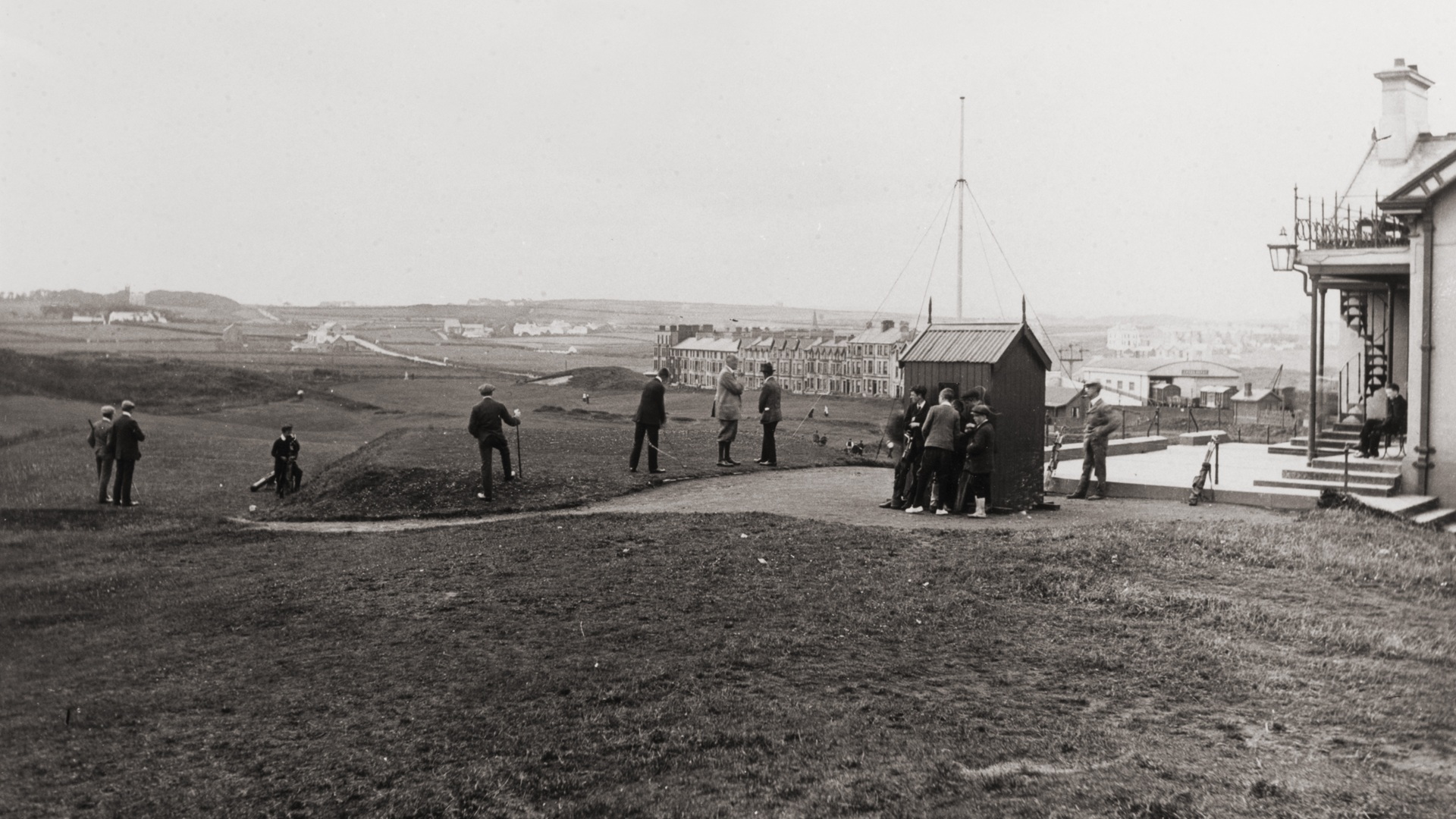
© Royal Portrush Golf Club
The County Golf Club first received royal patronage from Prince George, Duke of York, in 1892 and became known as the Royal County Golf Club. By 1895 it received further royal approval when the Prince of Wales, later King Edward VII, consented to become its patron. Now, it became known as Royal Portrush Golf Club. Today, there are only 63 ’Royal’ golf clubs in the world.

Masters of the Club
John Aitken was official club and ball-maker at Royal Portrush until 1905. Aitken patented several golf balls; ‘The Aitken’, ‘The Clan’ and ‘The Portrush Lily’, which was named after his first daughter, Lily. P. G. Stevenson. He became club professional and clubmaker in 1926 and remained until 1977. A renowned clubmaker, he made the driver that Fred Daly used when he won the 1947 Open.

© Royal Portrush Golf Club
Historic Landscapes
Harry Colt was a legendary golf course designer and was commissioned by Royal Portrush to draw up a new scheme which was formally opened in 1933. Royal Portrush now consisted of two courses with the original old ‘Triangle’ section abandoned. It was not until 1942 that the links received the names by which we know them today; ‘The Dunluce Course’ and ‘The ‘Valley Course’.

© Royal Portrush Golf Club
It was said that Colt had built a monument more enduring than brass, and he was so satisfied with the results that he lent his name to the 6th hole. Today, this historic landscape is carefully managed and maintained by Royal Portrush to ensure its preservation for future generations.
Rathmore Golf Club: Built by the Players for the Players
Prior to the founding of Rathmore Golf Club, golfers from Portrush were known as ‘The Town Players’ or ‘Resident Players’, known locally as ‘The Privileged Players’. With support from Royal Portrush, a new club was formed in 1947 called Rathmore Golf Club.
The founding fathers of Rathmore had a determination to make the game of golf accessible. As Rathmore Golf Club grew in numbers, a site was acquired for the building of a clubhouse. Members gave their trade and expertise voluntarily, while others donated building materials. The new clubhouse was opened in 1953.
Pioneer Players: Putting Portrush on the Map

© Royal Portrush Golf Club
A Ladies’ and Juveniles’ branch of the County Golf Club was instituted in 1891. Irish women golfers would achieve great success ahead of their male counterparts. In 1895, the Ladies Amateur Golf Championship, later called the Women’s Amateur Championship, came to Royal Portrush.

© Royal Portrush Golf Club
This event would have far-reaching effects for women’s golf. Lady Margaret Scott won the championship and demonstrated the skill in which a woman could play golf. This had a profound effect on the home players.
The Hezlets: A Family Affair
Mrs Hezlet was an excellent golfer; she was runner up in the Magill Cup, 1896. Mrs Hezlet was instrumental in encouraging her children to pick up a golf club. May, Florence, Violet and Emily all became leading figures in women’s golf in Ireland.
Lieutenant Colonel C. O. Hezlet, brother of the Hezlet sisters, was also a successful golfer. Lt. Colonel Hezlet would sit on the Championship Committee that brought the Open from across the water in 1951.
The Magill Cup
May Hezlet began playing golf competitively from a very young age, which helped to enhance her sporting talent and develop her into a world class golfer. In 1984, aged just eleven, she won her first ladies' competition, the Magill Cup.
May went on to win the Ladies’ Amateur Championship in 1899, 1902 and 1907, and the Irish Ladies Amateur Championship in 1899, 1904, 1905, 1906 and 1908.
Par–Excellence
In 1904 May Hezlet published her book, titled “Ladies’ Golf”. It was the definitive guide to women’s golf. She was progressive in her outlook and encouraged women to find an outlet in life. She wrote that golf was the game par-excellence for women.

© Royal Portrush Golf Club
Rhona Adair and Old Tom Morris
Rhona Adair began playing at the age of eight. In July 1899, aged 17, she became a talking point when she visited St Andrews in Scotland to play a 36-hole challenge with ‘Old’ Tom Morris. Prior to the match, Morris said: “I’ll no’ be licked by a lassie.” However, Morris had to withstand a spirited match and won by only a narrow margin.
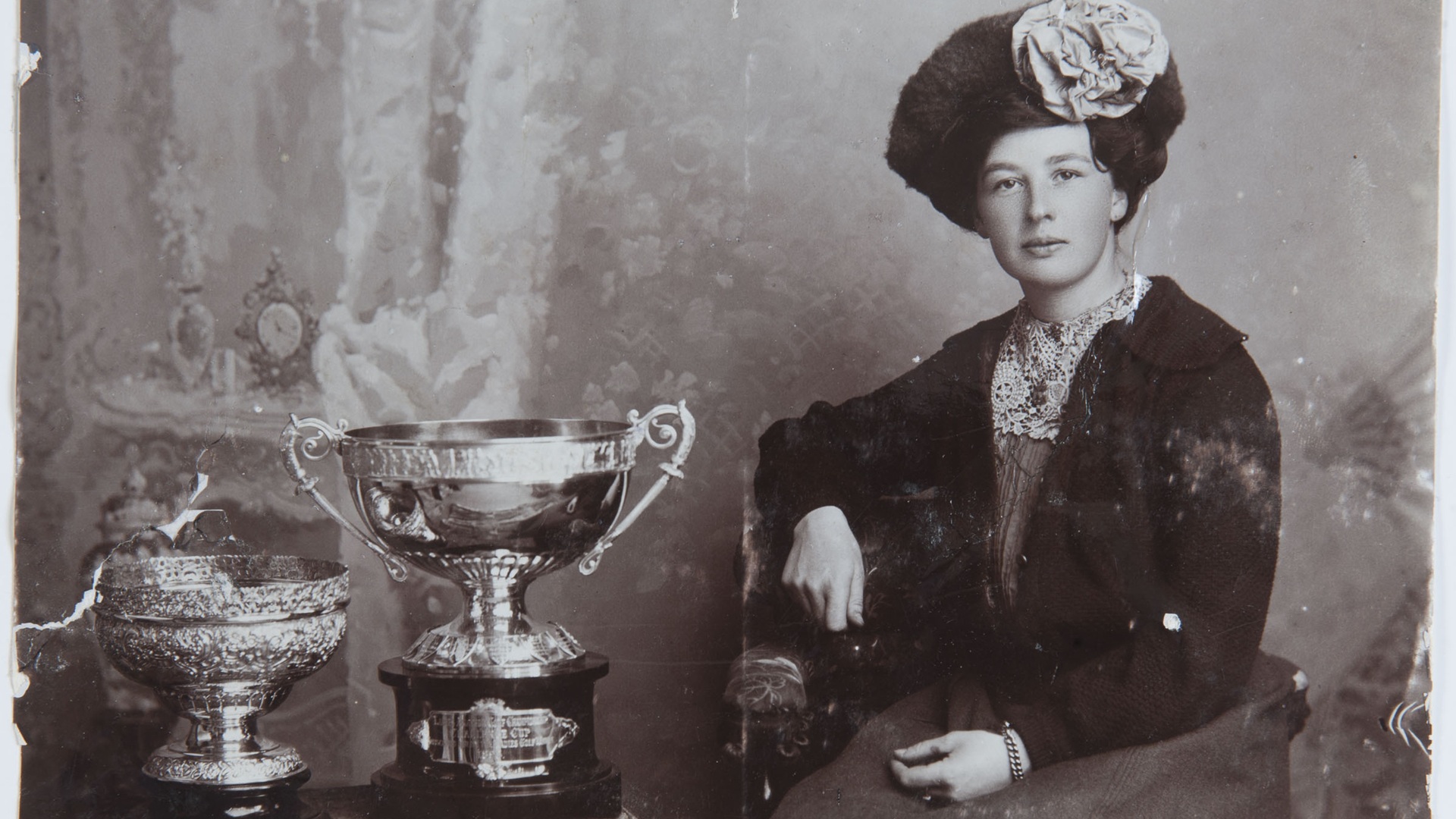
© Royal Portrush Golf Club
Adair was winner of the Ladies Amateur Championship in 1900 and in 1903, when it was played at Royal Portrush. In 1903 she travelled to the USA and Canada, where she experienced great success in exhibition matches.
16 Down
Rhona Adair, along with the Hezlet sisters dominated women’s golf competitions to the extent that, in 1907, T. H. Millar, then vice-president of the Ladies Golf Union, sent a team of four men to Portrush to play them. The authority of the women Portrush players was confirmed when all four men were comfortably beaten.

© Royal Portrush Golf Club
Worldwide links
In 1895, Issette Pearson was a competitor at the Ladies Amateur Championship at Portrush and Honorary Secretary of the Ladies Golf Union (LGU). She was instrumental in the development of a standardised handicapping system that went on to be adopted by golf clubs worldwide.
In 1905, the Curtis sisters competed in the Ladies’ Amateur Championship at Royal Cromer Golf Club. May Hezlet and Margaret Curtis played together in a match, and a great friendship developed between them. The Curtis sisters donated a cup for future international matches to promote friendships for women golfers and in 1932, the Curtis Cup tournament was born.
Women Wear Trousers!
On October 3rd, 1933, at the Women’s Golf Union Championship at Westward Ho!, Devon Gloria Minoprio caused a sensation and changed women’s golf forever by wearing trousers to play golf. Minoprio cut a striking figure at the 1939 Ladies Amateur Championship at Royal Portrush. She continued to flout convention by playing the match with only one iron called a cleek, today’s equivalent of a 1 or 2 iron.
Minoprio wasn’t the first woman to wear trousers at Royal Portrush. In 1937, during the Irish Ladies’ Championship, Mrs H. V. Glendinning wore trousers and went on to win, beating the favourite Mrs E. L. Kidd. Glendinning was later instrumental in the development of girls’ golf.
Ladies’ Golf Union
In 1883, the Ladies’ Golf Union was formed in response to the rapid increase in women taking up golf. The Ladies Amateur Golf Championship was set in motion with an elegant trophy named the Challenge Cup. At the time amateur Horrace Hutchinson said that it would never go the distance, and that women were physically not suited to golf. The Ladies Amateur Championship, later called the Womens Amateur Championship has been played at Royal Portrush nine times in total between 1895 and 2011.
The 1939 Ladies Amateur Championship
A tight contest between Pamela Barton and Mrs Marks in 1939 provided excellent golf, tightly fought to the last hole with Barton claiming the Challenge Cup. Barton’s uncle was Sir Dunbar Plunkett Barton, who had been president of Royal Portrush. She won the Ladies’ Amateur Championship at Southport in May 1936 and, that same year, won the American Women’s Golf Champion. Sadly, Barton died at age 26 in 1943 in a flying accident as a member of the Women’s Auxiliary Air Force.
A Bolt of Brilliance
The 1939 Ladies’ Amateur Championship brought to Portrush a talented young woman called Zara Bonner Davis. Some may know her better as Zara Bolton, who captained the winning Curtis Cup Team in 1956. The team visited Portrush early in the same year to play a series of practice matches against the Royal Portrush gentlemen.
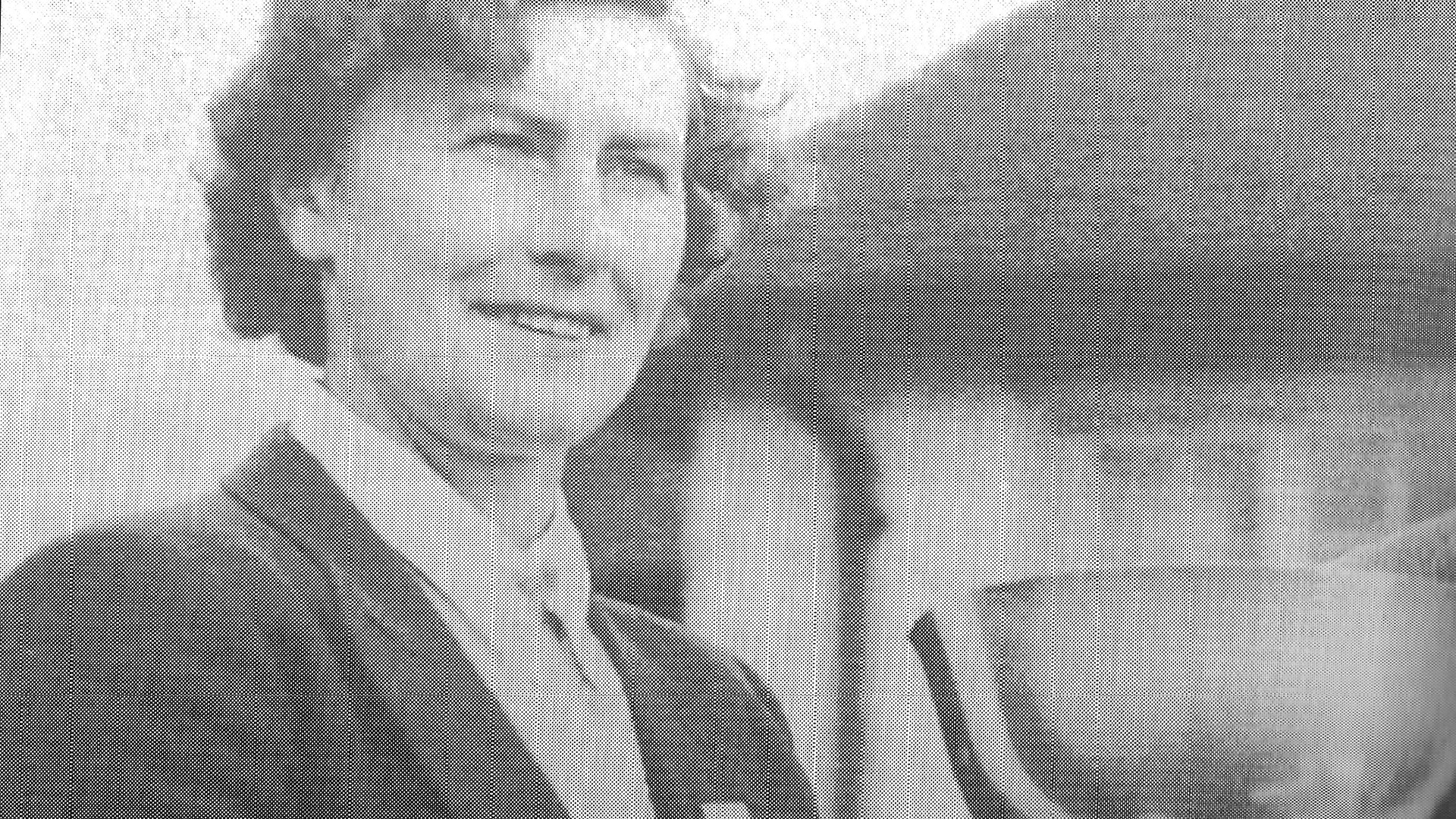
© Royal Portrush Golf Club
Portrush - A Place of Legends
Getting a Grip
The legendary Harry Vardon played at Royal Portrush against professional Alexander ‘Sandy’ Herd in the first professional tournament organised in Ireland in September 1895. It was refereed by Thomas Gilroy, who was instrumental in developing golf in Ireland and Portrush.
Herd went on to win the tournament and beat Vardon again in 1898. This was an amazing achievement, considering Vardon was Open Champion in 1896 and was to win the Open another five times.
Harry Vardon invented a new way of holding a golf club called ‘The Vardon Grip’, in which the little finger of the right hand is rested on top of the index finger of the left hand. Today, the grip is called the ‘Overlapping Grip’ and is still used by golfers today.
The Legend of Fred Daly
Fred Daly was born and raised in Portrush. He honed his golf skills as a caddie at Royal Portrush and went on to win The Open in 1947 at Royal Liverpool Golf Club, Hoylake. Accepting the Claret Jug, he said in his lilting Antrim accent: “I hope the change of air will help it.”
Daly also played in the Irish Open in 1947 at Royal Portrush, just a few days after winning the Open. Daly had won the Irish Open in 1946 and there were high hopes for him to win the 1947 Irish Open at Royal Portrush. However, he said his hand was sore from all the heartfelt congratulatory handshakes he had received because of winning the Open at Liverpool a few days before.
The Open 1951: Portrush
Numerous preparations had been made for the Open coming to Portrush in 1951. A small village of tents and marquees had sprung up around the clubhouse, but before the arrival of the Open, it was reported that the links were overrun with rabbits.
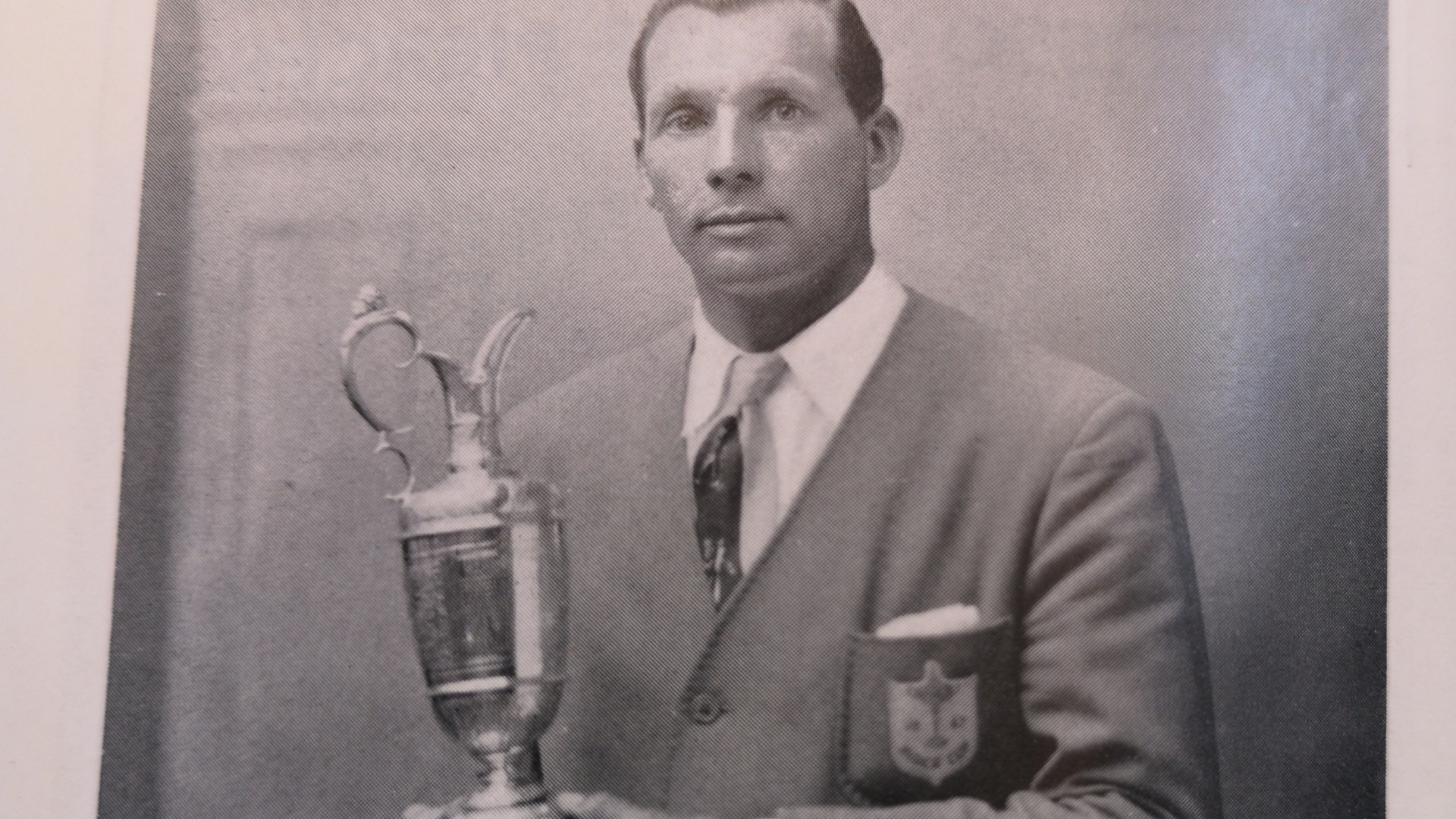
© Royal Portrush Golf Club
Royal Portrush became the first place where the Open was played outside of Scotland or England. Max Faulkner claimed the title of Champion Golfer at Portrush with a two-shot victory over Argentinian Antonio Cerda during a wet weekend. Home favourite, Fred Daly, finished fourth and, in typical Fred-fashion, he said that he got what he deserved.
Chartered Territory
The Royal Portrush links were not unknown to Faulkner, as he had come to play here in 1937 and later in 1947 in the Irish Open, in which he claimed third place. Harry Bradshaw claimed first.
When Faulkner won in 1951, he was cool and confident on the course, but when receiving the famous Claret Jug, he let it fall on the floor! He quickly recovered and during his speech said: “I just don’t care if I hit another golf ball. I’d like to spend my time farming and fishing.”
Cutting the Mustard

© Royal Portrush Golf Club
The 1951 Open is remembered for the skill in which Max Faulkner played the Dunluce championship links. However, a hot topic of conversation at the time was his choice of outfit; a glaring mustard ensemble! Clearly, Faulkner’s sense of style left quite an impression on local spectators.
Living Life to the Max
In a post-war world of austerity, Faulkner added colour and glamour to the game of golf. He was tall, athletic and, with his suntan, he cut quite a dashing figure. He played the 1951 Open at Portrush dressed in a horizontal striped shirt and primrose coloured plus fours.
His love of colour was said to have come from a war time incident. His ear drum had been perforated during an air raid in Liverpool and, while recuperating in hospital, he remarked that every morning the nurses would bring flowers into the ward, but that every night they took them out. He stated that the ward was so grey without flowers and that, should he ever get out of hospital, he was going to embrace colour.
Faulkner returned to Portrush in July 1995 to watch his son-in-law Brian Barnes win the Senior British Open. Faulkner was dressed as elegantly as ever.
The Open Returns to Royal Portrush
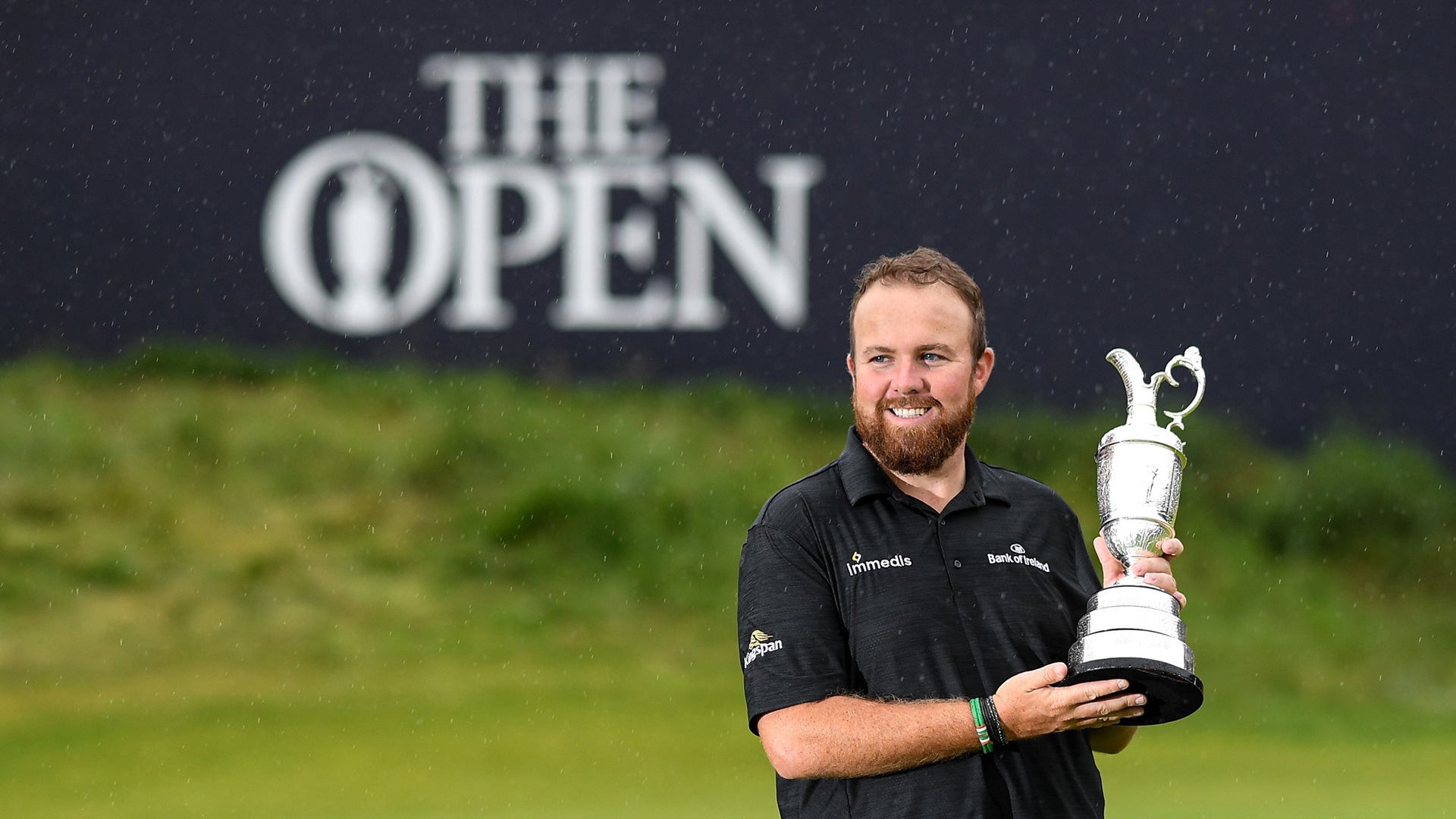
© The R&A
A defining moment in the town’s golfing legacy came in 2019, when Royal Portrush Golf Club hosted The 148th Open Championship. It was the first time in nearly 70 years that the prestigious tournament had returned to Northern Ireland — and the excitement was palpable. Over 237,000 spectators descended on the Causeway Coast during the week, making it one of the best-attended Opens in history and a landmark event for both the club and the town.
The Championship not only delivered unforgettable sporting drama — including Shane Lowry’s stunning six-shot victory — but also showcased Portrush’s natural beauty and warm hospitality to millions watching around the world.
From the roars along the Dunluce Links to the buzz across the town’s streets, The Open brought with it a sense of pride and celebration that rippled far beyond the fairways.
That momentous week cemented Portrush’s place on the global golf map — and the story isn’t over yet. The Open will return to Royal Portrush from 13th–20th July 2025, promising another unforgettable chapter in the town’s rich sporting history. As preparations begin and anticipation builds, Portrush is once again ready to welcome the world.
The heritage of golf in Portrush is more than a local history—it is a chapter in the chronicle of the sport itself. Through innovation, inclusivity, and a proud embrace of tradition, Portrush has consistently inspired the global golfing community. Its courses have witnessed iconic victories, its clubhouse welcomed royalty, and its pioneers have pushed boundaries in powerful ways.
From handmade drivers to international championships, the town’s impact reaches far beyond its shores. Today, Royal Portrush and Rathmore Golf Club stand as living landmarks, their fairways preserved not just for play but for the powerful stories they hold. The town’s unique position as both cradle and catalyst ensures that its legacy endures with dignity and purpose.
Portrush has not merely kept pace with golf’s evolution—it has helped guide it. And as the game moves forward, this small coastal town remains a mighty presence at its heart.









